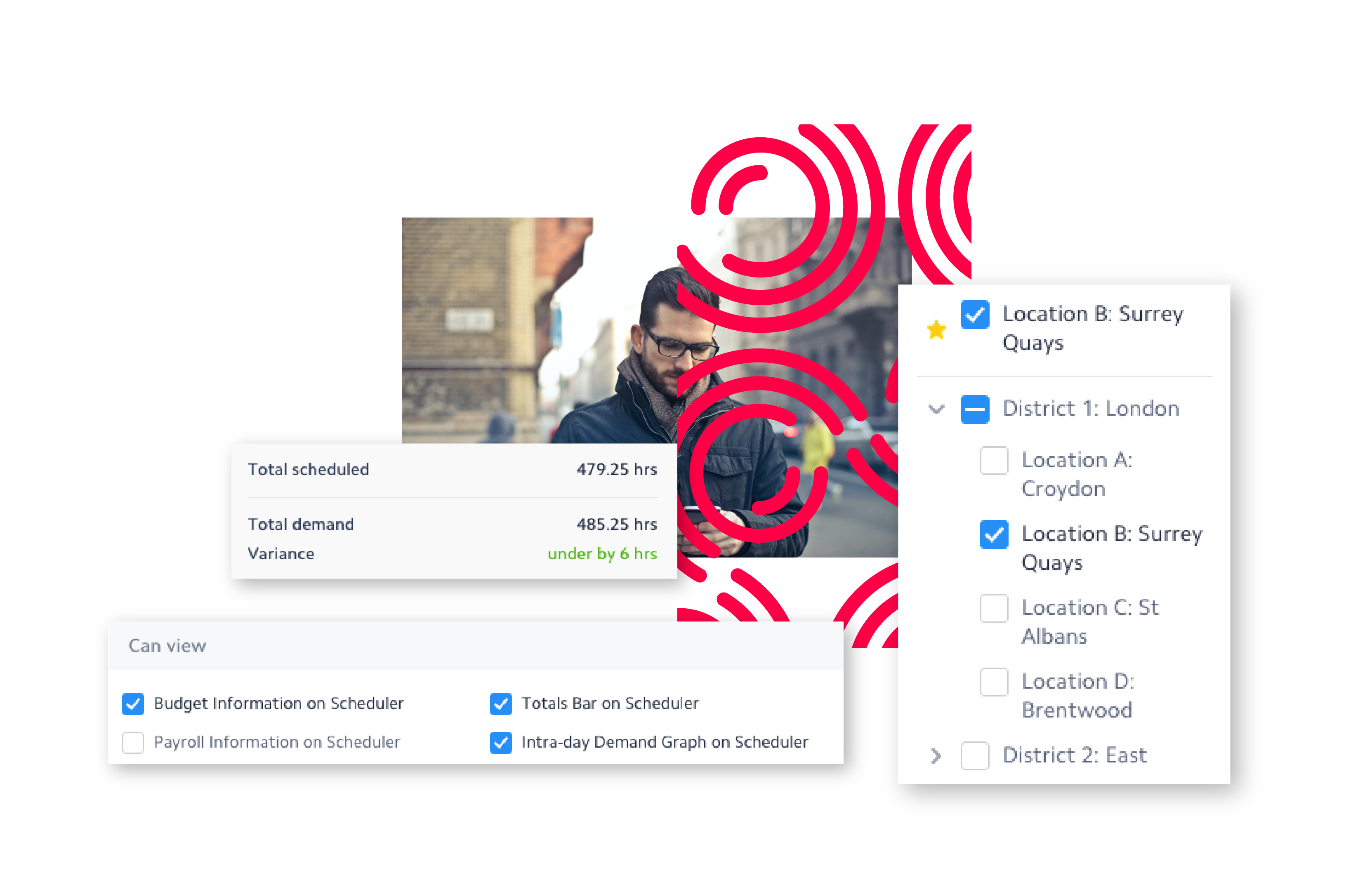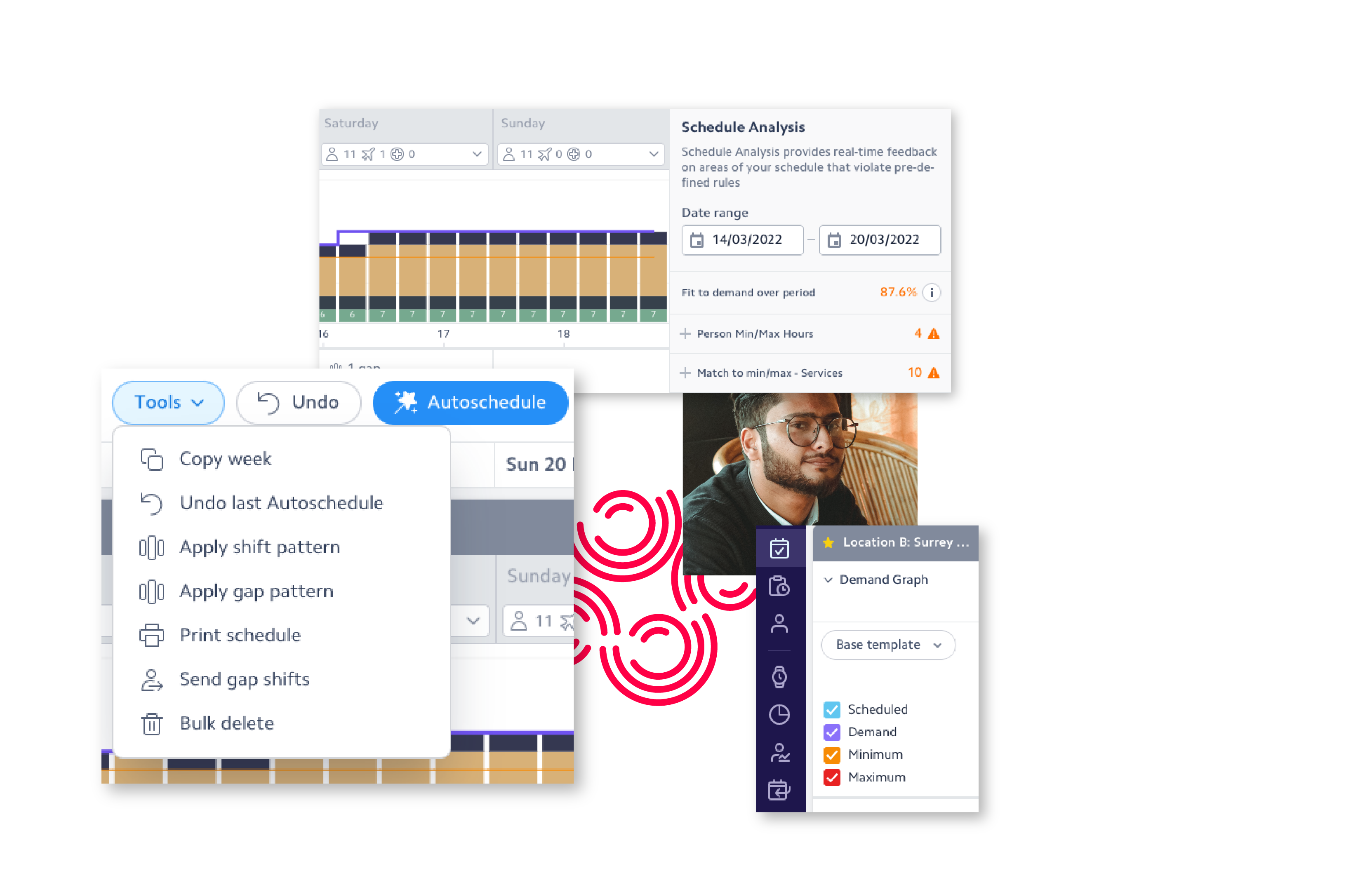-
Solutions
Solutions
- View All Solutions View all of our workforce management solutions
- Digital Scheduling A core workforce management solution for rota planning that’s simple and smart.
- Auto Scheduling Take your workforce management to the next level and automate the optimisation of staff rotas in seconds, with one click.
- Forecasting Complete your workforce management solution and perfectly predict labour to demand, to create the perfect schedule or rota every time.
-
Features
Features
- View All Features View all of our workforce management solutions
- Shift Planning Plan shifts using our digital scheduling software
- Mobile App - Employee Engagement Improve communication and create a transparent approach to scheduling for your workforce.
- Clocking In/Out Manage employee schedules and clock in and out for shifts
- Leave & Absence Management Request, approve, and track leave and absence for your workforce from one solution.
- Timesheet Tracking & Attendance Manage hours scheduled vs hours worked and automatically create timesheets to send to payroll
- Insights & Reporting Customisable reporting to track the workforce metrics that matter.
- Integrations Integrate our workforce management solutions and schedules into other tech seamlessly
-
Industries
Industries
- View All Industries View all of our industries
- Retail Helping retailers spend 1:1 time with customers - not the rota.
- Hospitality Serving the hospitality industry with first-class rotas.
- Entertainment & Leisure Game-changing scheduling as engaging as your business.
- Healthcare Whether you're a private service or large trust, Rotageek is here to help.
- Other Sectors Helping a host of workforces to meet fluctuating demand.
- Customer Stories
-
Resources
Resources
- Free Downloads From white papers to webinars, we've got you covered.
- Blog All the latest industry insights from the Geeks.
- News & Articles Rounding up all the latest in scheduling.
- Savings Calculator Calculate how much can you save with digital scheduling
-
About Us
About Us
- Why Rotageek? What makes us a different type of scheduling solution?
- Moving to Rotageek Live your best scheduling life when you move to Rotageek.
- Partners Our partner ecosystem to supercharge your scheduling solution.
- Our Story The Rotageek story so far.
- Meet The Team The Geeks behind the scenes.
- Careers Meet the team and become a rota geek.
- Contact Us Get in touch and speak to a geek.
- Watch Demo
- Book a Demo
WORKFORCE FORECASTING SOFTWARE
Labour Forecasting
Predict labour to demand and create the perfect schedule or rota everytime.

Complete your workforce management solution with Forecasting. Our solution predicts your customer demand to optimise staff schedules and rotas based on the demand that's driven from your customers.
Following the data, rather than intuition, align your labour to demand using different labour forecasting models to suit your budget, service levels and staff availability. Rotageek’s forecasting algorithms combine historic data, trends and events to predict the labour demand for each task by location, down to 15-minute increments.
Increase basket size, conversion rate and NPS scores with market leading workforce forecasting.

Cost Efficient Labour to Demand Match.
Maintain a competitive edge cost-effectively, by forecasting your labour and workforce schedules with precision. Our forecasting algorithm results in a resilient planning strategy, optimising budgets to prioritise customer service. Our customers report improving their labour to demand match by up to 25% by optimising and maximising contract types, skillset and availability across locations.

Forecast Your Way.
Top down or bottom up? We can do both! Set your labour budget by hours or spend, and apply it to your forecasting process. Or apply a bottom up forecasting labour model to show the best time to schedule employees, centred on your customer demand.
With task durations set by you (for example how long it takes to serve a customer) and using trends, events and historical analysis, labour requirements per hour are forecasted, and shifts or schedule gaps are filled accordingly.
Variables impacting staffing requirements can fluctuate frequently, so Rotageek provides 15-minute granularity forecasting for a defined location or task.

Evidence Based Customer Demand.
Minimise disputes or uncertainty by implementing evidence-based scheduling that justifies decisions. Through harnessing the power of AI, your workforce management continually improves and adapts in response to customer demands. Stand out as a pioneering employer with digitised scheduling processes that look after your workforce – as well as your bottom line.
How it works
Rotageek’s Forecasting solution uses any data point, for example, store footfall, transactions or patient check-ins to perfectly predict future demand down to a 15 minute interval.
With a custom-configured machine learning algorithm, it takes into account your staffing levels to accurately forecast labour demand and support our Digital Scheduling or Autoscheduler solutions in delivering even better schedules to suit your business.

“Rotageek allows our General Managers in shops to plan their staff rotas more precisely, with greater insight into what skill sets they need on the floor during busy periods. This allows our GMs and their teams to focus on delivering great service to our customers.”
FAQs
-
How does automated staff forecasting work?
Staff forecasting software flags changes in demand sure to impact who you need and where you need them at different times. Making effective use of supply and demand models, Rotageek accounts for your business budget, service levels, and staff availability. So you can make employment and scheduling decisions in advance, based on data rather than intuition.
Key features of Rotageek include:
- Demand forecasting
- Autoscheduling
- Leave & swaps management
- HR & Payroll integrations
-
How does staff forecasting software make use of AI?We’re the geeks so you don’t have to be. Rotageek is integrated with a custom-configured machine learning algorithm that factors in your staffing levels and makes accurate predictions of demand. With automatic reference to relevant data points, you’re able to create schedules that align with trends, time, and resources. And with Rotageek AI taking care of fluctuating labour demand, you’re free to focus on what matters, like spending more time with your customers.
-
What makes Rotageek the best workforce planning software?Rotageek stands out as the best workforce management software due to our ability to blend complex strategic workforce planning tools with slick workforce scheduling features. Our platform provides you everything you need to get your team sorted, from essential employee scheduling software to big-picture strategic workforce planning systems. Offering next-gen workforce planning software solutions, Rotageek ensures your staff scheduling is as efficient and effective as possible.
-
Is staff forecasting software more effective than manual or spreadsheet-based forecasting?With advanced data-driven forecasting capabilities, there’s no denying that Rotageek is more effective than a human or spreadsheet. Drawing on concrete data you can save significant amounts of time, scheduling to meet customer or patient demand. Users of our staff forecasting software have reported a 25% improvement in shift-demand accuracy. *Moves spreadsheet to the bin.*
-
Does staff forecasting software integrate with other IT tools?Designed to work with our pioneering Autoscheduler, the Rotageek online platform and software package is designed for seamless integration. So you can start making precise forecasts based on the most relevant business data in next to no time. All that’s needed is a single week of data to begin forecasting with Rotageek.
-
Is staff forecasting software expensive?
Scheduling smarter is kind on the environment, resources, as well as your pocket. Find out your return on a smart scheduling solution with our free and easy to use ROI Calculator. With the creation of precise labour and workforce schedules, customers have reported an 8% reduction in labour spend through the optimisation and maximisation of contract types, skill sets, and availability across locations. Not only does staff forecasting deliver an outstanding ROI, it helps reduce the burden of stress, time, and churn. Speak to a geek to find out about the range of cost-effective options.
-
What makes Rotageek the best workforce planning software?
Rotageek stands out as the best workforce management software due to our ability to blend complex strategic workforce planning tools with slick workforce scheduling features. Our platform provides you everything you need to get your team sorted, from essential employee scheduling software to big-picture strategic workforce planning systems. Offering next-gen workforce planning software solutions, Rotageek ensures your staff scheduling is as efficient and effective as possible.
- Quick links
- Log In
- Book a Demo
- Help Centre
- Products
- Digital Scheduling
- Autoscheduling
- Forecasting
- Company
- Our Story
- Careers
- Blog
- Privacy Policy